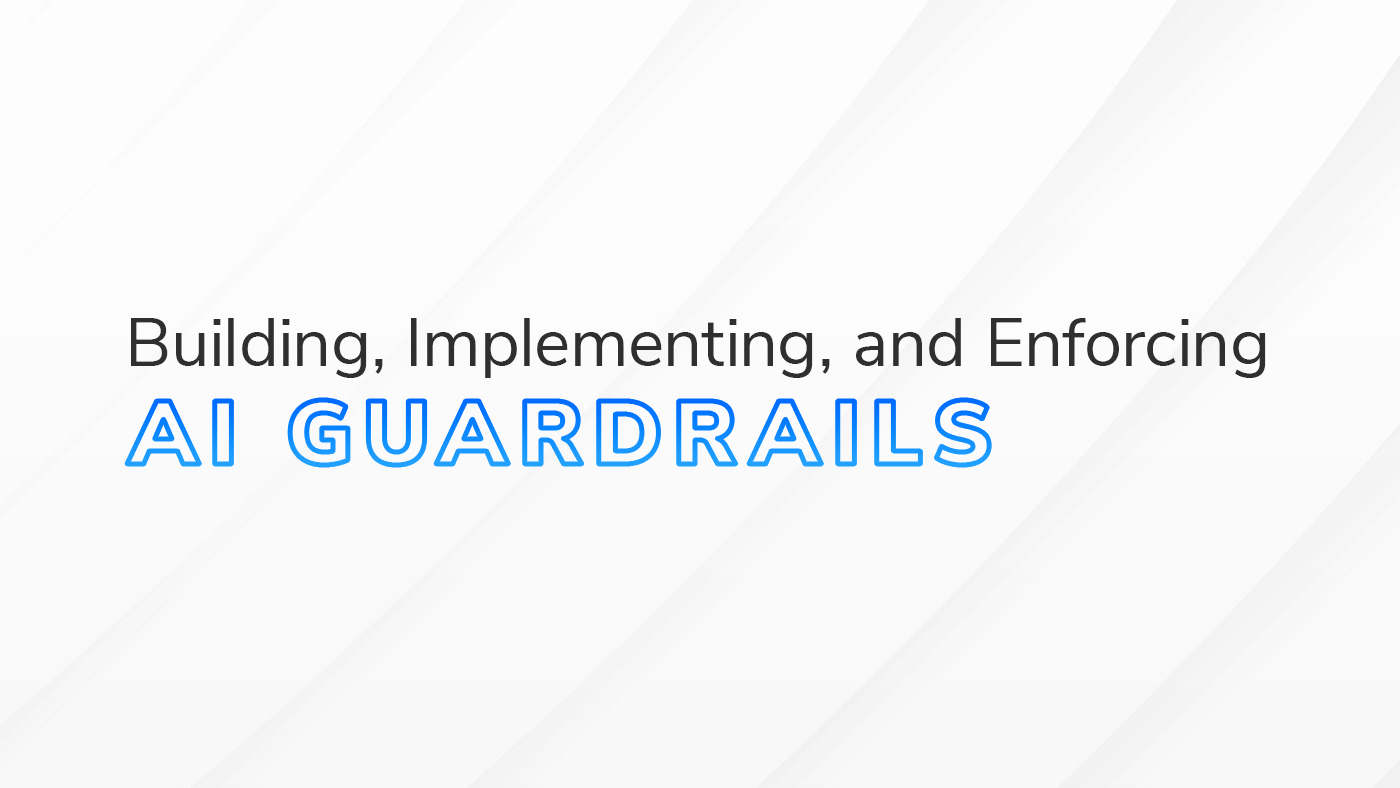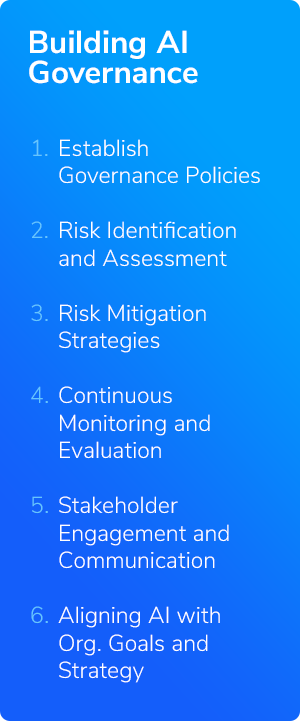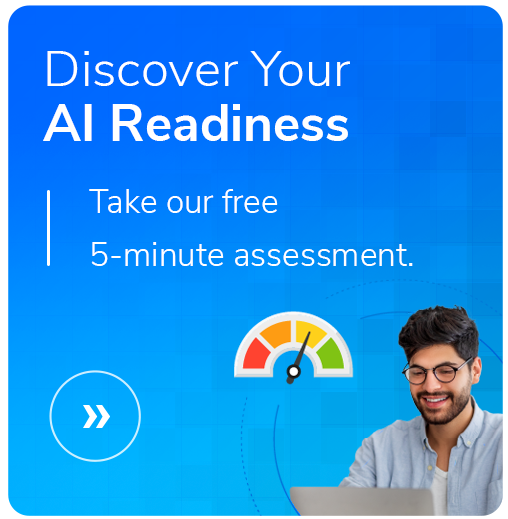AI Governance for Trustworthy AI Deployment
- Written by: Ben Hall - Practice Manager, GRC

Artificial intelligence has quickly established itself as one of the most prevalent technologies in our lives. All the major players—Microsoft, Google, Apple, etc.—and the increasing majority of everyone else have invested largely in AI systems.
The International Data Corporation (IDC) estimated that the majority of Forbes Global 2000 companies each had more than 100 machine learning models in production in 2023. At least a quarter of those G2000 companies credited their AI capabilities with adding more than 5% to their earnings.
Enterprise AI’s growing breadth and complexity is forcing the hand of organizations all over the globe to establish AI governance—providing guardrails to a technology that is actively changing how we work, and how we interact with the world.
In part one of this two-part blog series, we covered AI Risk Management Frameworks (RMF)—what they are, why they’re so important, and recommended development and implementation guidelines.
In this blog, we’ll zoom out a bit and discuss AI Governance as a whole—what it includes, why it's needed, how it works with an AI RMF, and tips on implementing and enforcing it.
What Is AI Governance?
AI governance involves setting up policies, procedures, and frameworks to guide the development and deployment of AI systems. It ensures that AI is used ethically, responsibly, and in line with regulatory requirements.
As IBM defines it, AI governance establishes the frameworks, rules, and standards that direct AI research, development, and application to ensure safety, fairness, and respect for human rights.

Why Is AI Governance Important?
We're currently living in a time when AI is rapidly transforming everything from our workplaces to our social media feeds. We’ve seen plenty of examples of AI missteps or misuse, and as AI continues to become ubiquitous, guardrails are needed to ensure it is developed and used responsibly.
- Preventing harm: The most crucial reason AI governance is needed is safety. AI can cause—and has caused—harm ethically, legally, and even physically. Governance helps us avoid these pitfalls as much as possible by managing risks and promoting fair, ethical, and safe AI.
- Building trust: For AI to truly thrive, people need to trust it. Governance frameworks provide transparency and explainability in how AI decisions are made. This helps ensure AI doesn't violate human rights or dignity.
- Sustainable development: AI models can change over time, and their outputs can sometimes become unreliable. Effective governance goes beyond one-time compliance and further into maintaining ethical standards and social responsibility throughout an AI's lifespan. This safeguards against financial, legal, and reputational issues while promoting responsible technological growth.
In short, AI governance helps us steer AI's future toward a positive impact. By balancing innovation with safety and fairness, we can ensure AI benefits everyone.
Building AI Governance
It is clear why AI governance is needed. But how do you develop these standards and policies? Developing robust AI governance requires a multi-faceted approach encompassing several vital components.
- Establish Governance Policies: Comprehensive documents that cover AI data privacy, security, ethical use, and compliance with legal and regulatory standards. Examples include generative AI Use policy, Data Governance policy, and AI Incident Response plan. Roles and responsibilities should also be assigned for managing AI systems for clear accountability.
- Risk Identification and Assessment: Your AI Risk Management Framework should handle most of this. Use your AI RMF to identify potential risks associated with AI applications, assess them based on likelihood and impact, and prioritize themaccordingly.
- Risk Mitigation Strategies: Develop strategies to mitigate identified risks. These strategies should include rigorous testing of AI systems, securing data, and establishing fallback procedures.
- Continuous Monitoring and Evaluation: Perhaps nothing exemplifies a quickly changing technology landscape more than artificial intelligence—you cannot afford to set your AI governance and walk away. Establish a practice of continuously monitoring AI systems to detect and address any issues that arise during operation. Make sure to include regular audits and assessments to align with compliance and identify areas for improvement.
- Stakeholder Engagement and Communication: Engage with stakeholders to understand their concerns and expectations regarding AI use. Maintain open communication channels to keep stakeholders informed about AI initiatives and governance practices.
- Aligning AI with Organizational Goals and IT Strategy: Ensure AI initiatives align with your organization’s broader goals, values, and IT strategy. Integrating your AI governance with your overall risk management framework and your IT strategy creates a cohesive approach.
Establishing these components allows for a structured and practical governance foundation for AI.
Tips for Implementing and Enforcing AI Governance in Your Organization
Moving AI governance from the idea stage into practice might seem like a heavy lift. However, ensuring that AI systems operate safely, ethically, and effectively is crucial. We have some actionable tips to help you get started and maintain strong AI governance in your organization.
- Gain Executive Support: Secure buy-in from top leadership to prioritize AI governance as a strategic initiative. Ensure executives understand the importance of AI governance and its impact on organizational success to drive top-down commitment to ethical and safe AI practices.
- Educate and Train: Training all employees involved in AI projects helps them understand governance policies and their importance. Regular workshops, courses, and continuous learning opportunities can help maintain high awareness and adherence to your AI standards.
- Have Clear Guidelines: Create easily accessible guidelines and documentation that outline your organization’s AI governance policies and procedures. The more user-friendly and practical these documents are, the more likely your employees will apply their principles in their AI use.
- Encourage Open Communication: When employees feel comfortable reporting issues or concerns, potential problems are identified earlier, preventing minor issues from escalating into significant risks. Taking feedback seriously and addressing concerns promptly demonstrates a commitment to ethical practices and strengthens trust within your organization.
- Employ AI Monitoring Tools: Use advanced monitoring tools to track your AI systems' performance, compliance, and potential risks. These Artificial Intelligence Operations (AIOps) tools—like Microsoft Azure Monitor, IBM Watsonx Governance, or Google’s Vertex AI—provide insights and alerts into your AI systems, evaluating and monitoring for system health, accuracy, drift, bias, and generative AI quality.
Following these tips can help you establish and enforce a strong AI governance structure that supports ethical and safe AI development and deployment across your business.
AI Governance and an AI Risk Management Framework
AI governance is different from an AI Risk Management Framework in that it is a broad concept that encompasses the policies, principles, and practices used to guide and oversee the development, deployment, and operations of AI systems.
So how do these two structures work together?
- Guiding Principles, Practical Solutions: AI governance establishes high-level goals like fairness, transparency, and accountability. An AI RMF translates these goals into concrete actions based on risk and focused on security.
- Building Trust through Transparency: One of AI governance’s core principles should be building trust with all stakeholders. An AI RMF helps achieve this by promoting transparency in AI systems. The framework establishes how organizations understand the way AI makes decisions and the process of data handling.
- Proactive Risk Management: AI governance emphasizes proactive risk management, which is the crux of an AI risk management framework. Continuous monitoring and evaluation of AI systems through the lens of an AI RMF allows organizations to identify potential problems before they occur.
In essence, AI governance sets the direction, and an AI RMF provides a roadmap for achieving responsible AI development and use.
AI Governance: Trust and Responsibility
AI is actively changing our world, but it needs active governance and a commitment from all of us to use it responsibly and effectively. AI systems must be built on a foundation of trust for everyone to benefit from its full potential.
For guidance on AI governance, an AI Risk Management Framework, or how you can leverage AI in your day-to-day operations, contact HBS today. We’re invested in AI and invested in your success.






